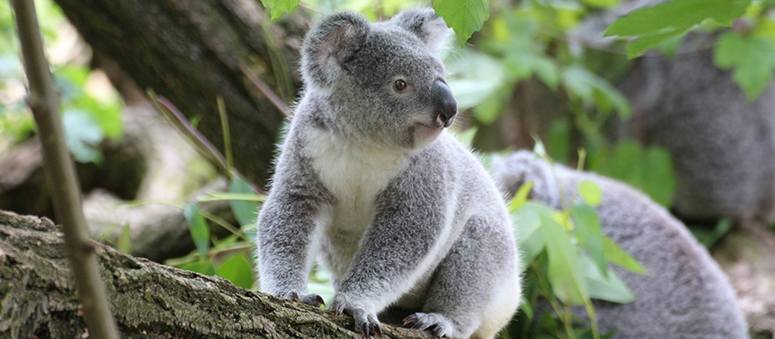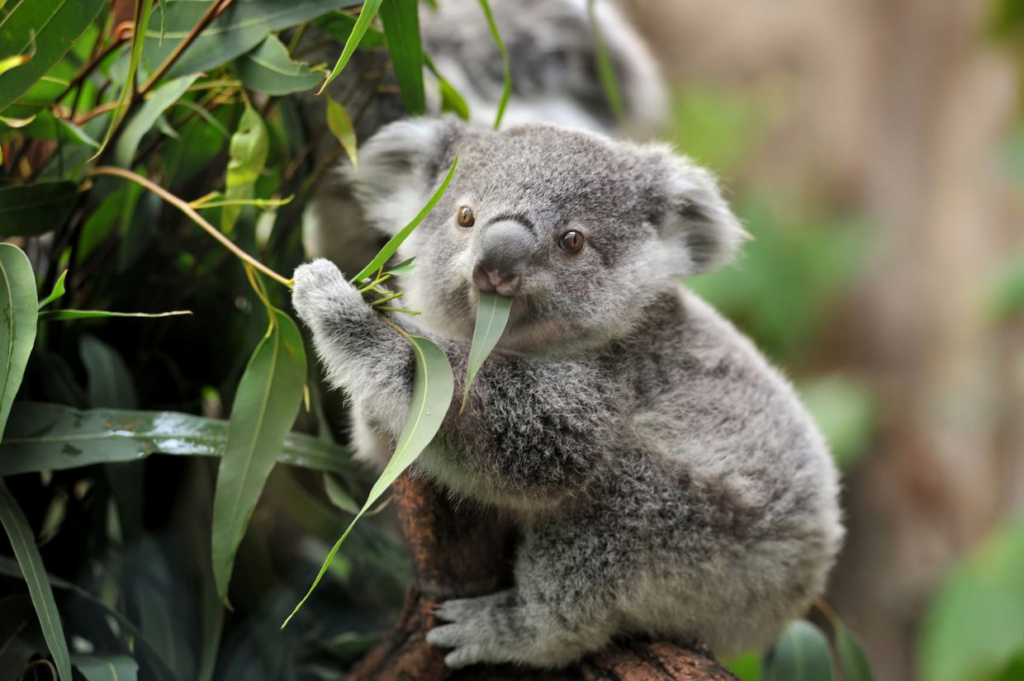An animal with fingerprints similar to human fingerprints

An animal with fingerprints that are very similar to human fingerprints, to the point that it is not possible in any way to differentiate them from human fingerprints. So what is that animal and why did God Almighty single it out with those fingerprints?
The reason for the presence of these fingerprints is that this animal feeds on the leaves of a particular tree, and those fingerprints help it sense and know whether those leaves are ripe and edible or not. These fingerprints also enable it to tighten its grip on the leaves, Glory be to God!
The koala, also called the koala bear, is classified as a marsupial. It lives in trees and belongs to the vertebrate division. Its original habitat is southeastern and eastern Australia. It also lives in eucalyptus tree forests and is found in Queensland, but it is smaller in size and the color and density of its fur varies.

Koala length:
The length of the koala ranges between 60-85 cm.
Koala weight:
The weight of a koala can reach 14 kilograms.
Characteristics of the koala:
The koala has a strong build and is gray in color. Its chest can be pale yellow or lighter. It has a broad face and a round, leathery nose, in addition to large ears and small eyes. Its feet are strong with claws.

the Kuala animal
Average lifespan of a koala:
It lives in the wild for an average of 10 to 12 years, and the female koala may reach the age of 18 years. It is also believed that the lifespan of males is slightly shorter than that of females.
Types of koalas:
Koalas are classified according to fur colours, thickness and size. Some of them are as follows:
Brown koala:
It is the largest type of koala in Australia and is also known as the Victorian koala and the southern koala. It is often found in the states of Victoria and South Australia and has the thickest fur among all other species.
Gray koala:
It is the smallest koala in Australia and is also called the Queensland koala and the northern koala. It is distinguished by having the least fur among all koala species.
Brown gray koala:
It is also called the New South Wales koala, and this species is very rare and threatened with extinction.

Koala behavior:
The koala home consists of several trees and the area is called the koala home range.
A mature male has a sticky, scented gland in the center of his white chest that he rubs on trees to mark his territory.
Koalas communicate with each other through a set of sounds, and their sound is called bellowing.
Koalas in the southern parts of Australia are larger and have thicker fur than those in the northern parts.
The koala has a pouch, or what is called a pouch, located towards the back legs, in which the female is placed after giving birth until she grows up.
Koalas have poor eyesight and rely on other senses such as hearing and smell.
Koalas may reach speeds of up to 30 kilometers per hour when they sense danger.
The koala's digestive system enables it to break down eucalyptus leaves without being affected by the toxins contained in them.
Koala feeding:
The koala eats from half a kilogram to one kilogram of leaves per day, depending on its sex, size, and where it lives.
Do you know who the real zombie is, who appears in his terrifying form in horror movies?
The koala gets moisture from gum leaves, but in times of drought the leaves may not contain the necessary moisture, so they may resort to drinking water.
It eats eucalyptus leaves, approximately 600 species of eucalyptus trees, as eucalyptus trees have low calories and nutritional content, so they do not provide the koala with much energy.

How much sleep does a koala need?
The koala is a nocturnal animal. It wakes up at night and sleeps during the day. It is possible for it to sleep part of the night and move around during the day. The average number of hours of sleep for it ranges between 18-20 hours during one day. The reason for the large number of hours of sleep is that it requires a lot of energy. For the digestive process.
Predators of koalas:
The koala lives high in trees, which makes it in a safe position, but it has few predators, including:
Dingo.
Big owl.
Dogs.

Koala health:
Diseases may affect the average lifespan of the koala, and the following are some of the diseases that may affect it:
Chlamydia
It is a bacterial infection that affects koalas in southeastern Queensland. It weakens the immune system and may cause blindness and reproductive system diseases that may cause infertility.
Retroviruses
Which may lead to a weakened immune system, leukemia and lymphoma.
Benefits of koalas in the ecosystem:
It reduces the possibility of recurring fires by consuming excess vegetation in eucalyptus forests. Koala droppings also feed shrubs and serve as food for small insects and rodents, especially during the rainy season.
There are many other animals that feed on eucalyptus leaves, but they cannot climb higher, so they feed on the leaves of the branches that koalas dedicate.
Koalas are considered part of the food chain, as they are prey for carnivores. Koalas also contribute to the Australian economy through tourism, as they are a tourist attraction for visiting Australia.

Reproduction:
Young cola are known as joeys. Young females give birth once a year and this depends on a number of factors, while older females give birth every two or three years.
The young are born 2 centimeters long and are blind and furless. They grow and develop in the mother’s pouch. When a baby koala is born, it relies on the senses of smell and touch, as it has strong limbs. Once it reaches the mother’s pouch, it remains for a period of no less than 6-7 months to obtain the necessary nutrition.
A few weeks before emerging from the pouch, the young feed on a substance from the mother, which is a specialized form of her soft and liquid waste. When emerging from the pouch, it rides on its mother’s belly or back and continues to return to the pouch to obtain milk.
The young leaves its mother after a period ranging from one to three years. The male koala begins to mate at the age of two to four years, and the female can mate at the age of two years.
Adaptation methods:
The koala's five claws help it hold on to tree branches firmly and facilitate the process of catching food.
The koala is adapted to live in eucalyptus forests in the bends of branches, as its tail is low, its spine is curved, and it has a rounded back.
On hot days, the koala stays against the trunk and low, shaded branches, and on cold days it stays away from the trunk where it can absorb heat from the sun.
The front incisors of the koala teeth help in cutting tree leaves and branches, while their back teeth help in cutting the leaves into small parts, and the strong jaw works to turn the fibrous leaves into a smooth paste in the mouth.
Threats facing koalas:
Forest fires and diseases that may affect the trees on which the koala feeds are among the threats that it may face in its environment and living areas.
Source: websites

